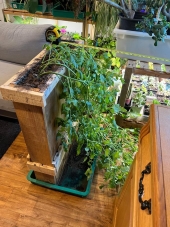









Trying to achieve self-reliance on a tiny suburban plot: http://gardenofgaladriel.blogspot.com
 1
1




It's never too late to start! I retired to homestead on the slopes of Mauna Loa, an active volcano. I relate snippets of my endeavor on my blog : www.kaufarmer.blogspot.com









Invasive plants are Earth's way of insisting we notice her medicines. Stephen Herrod Buhner
Everyone learns what works by learning what doesn't work. Stephen Herrod Buhner
 1
1








Galadriel Freden wrote:It might be that your potting compost isn't rich enough, or perhaps too compacted. I've noticed the conventional potting compost I buy seems to compact fairly quickly, and needs to be mixed with something to keep it fluffy.
I used a new bag of "Black Gold" organic potting soil. It has the little white thing in it too. I do save the contents of the bags of my better teas after it's dried, so I can mix that in if need be. Might be a good idea to do so.




Su Ba wrote:I've fairly well determined that seedlings need to be transplanted early into a deeper growing situation.
Fertilizer is another issue. Potting soil doesn't usually have enough nutrients for continued rapid growth. There are organic type liquid fertilizers available.




Craig Overend wrote:If they are LEDs and not hot to touch, the closer you can get the lights to the plants, the better. NASA studies I've seen have even embedded their LEDs inside the plant canopy to maximise use of the power available. You could also try adding a reflective material around them. Basil ideally needs about 6 to 8 hours of bright sunlight per day.




Anne Miller wrote:Everyone has given you great answers so this is all I can offer ...
It might help to get some cardboard, put foil on it and surround your plants to act like mirrors so the plants can get more sun.
Also on your food scrap plants try to get them to turn green and growing before putting in soil. Be sure to change the water every day so they have fresh water. But don't let the water be too deep.
Have you thought about doing sprouts or microgreens? I do sprouts in the winter when I can't grow outside. I use dry beans from the grocery store. They have to be cooked so I put them in soup. I have not done microgreens.




Casie Becker wrote:Something I that stuck with me when I was researching building lights for aquariums (just researching, I never actually built one) is that a flat white surface is actually more reflective than aluminum foil. I like the idea of reflectors to maximize the use of already available light. Just remember to use actual mirrors (which may turn up cheap at resale shops) or flat white surfaces.
edit: I should just make a signature that reads "had to correct spelling/grammar" and save some typing




My Etsy shop: https://www.etsy.com/shop/SecondChanceCeramics




Antonia Barry wrote:http://www.cheapvegetablegardener.com/cheap-led-light-and-grow-box/
Here is a link to an inexpensive grow light set up using Christmas lights. This is the season for after-christmas sales, so I thought this might be of use. You could set your starts in this at night, so you don't miss any natural sunlight.
Also, I second the microgreens suggestion. They are mostly sprouts that have been allowed to green up some, and so take less sunlight than full grown plants. I've used lentils from the grocery store to make sprouts, too.





|
This tiny ad turned out a lot bigger than I thought it would
Homestead Pigs Course
https://permies.com/wiki/365748/Homestead-Pigs
|





